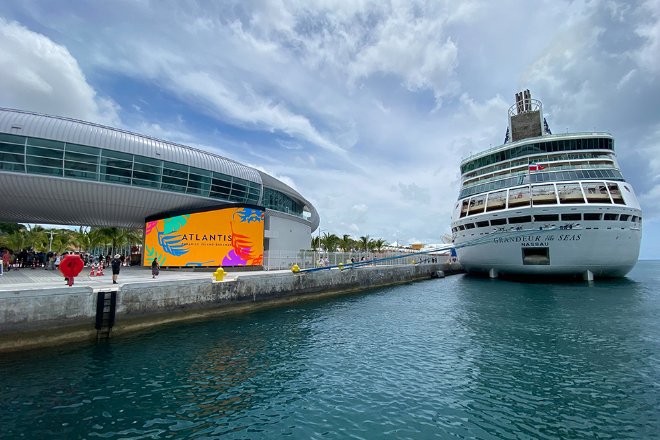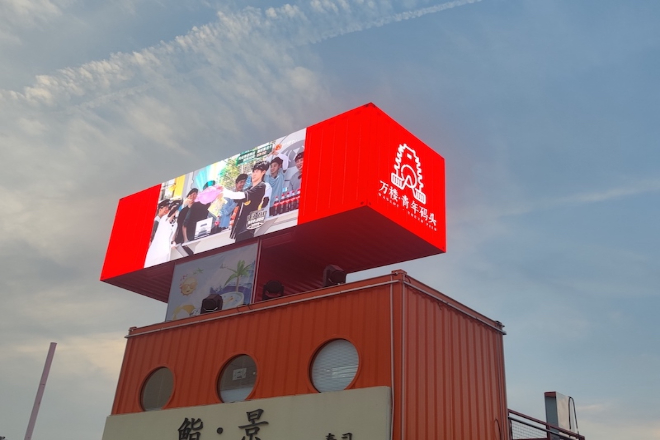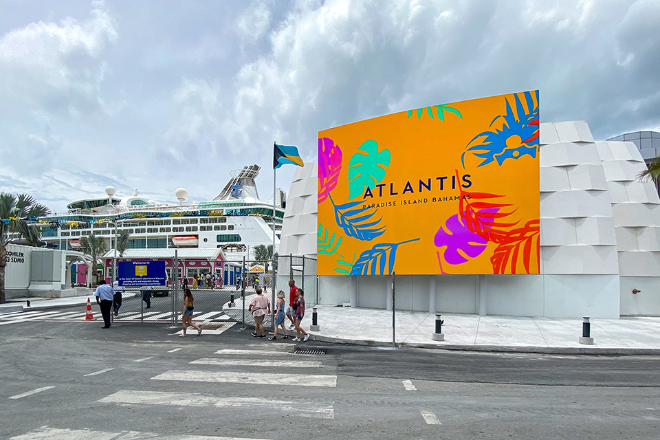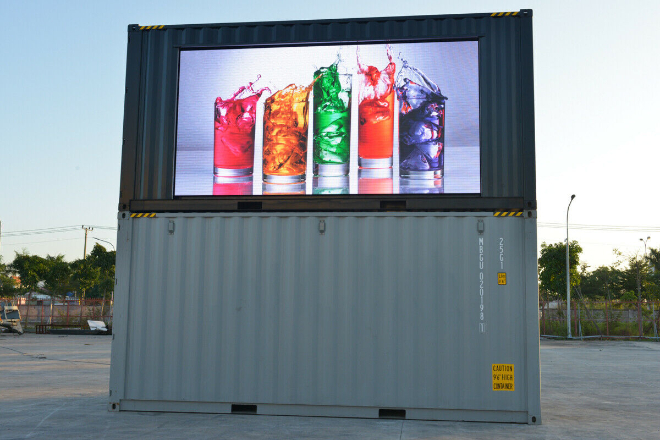Introduction
The dock, a busy logistics hub, is playing out countless stories every day. Crew members, cargo owners, workers… everyone is busy, but poor information transmission is often their biggest trouble.
Have you ever thought about what kind of scene it would be if there was a technology that could make all this simple and efficient? So, how much role can LED display screens play in docks?
Table of Contents
1. Dock operating environment and information transmission needs

1). Daily situation at the dock
The dock is a super busy place, like a huge logistics hub. Ships come to dock, cargo needs to be loaded and unloaded, people need to get on and off the ship, and all kinds of things are happening at the same time.
There are many roles involved here, such as crew members, cargo owners, logistics company personnel, customs.
And border inspection staff, and the dock’s own operators. Everyone is busy with their own things, but they have to work closely together.
The work at the dock is particularly complicated, and the types of goods are varied, including those in containers, bulk, and dangerous goods.
Each type of cargo is handled differently. Moreover, the dock is large, with equipment, scattered personnel, a noisy environment, and various machines rumbling, which makes it particularly difficult to transmit information.
2). Why does the dock have high requirements for information transmission?
In the dock, if the information transmission is slow, wrong, or not visible to everyone, it will be a big trouble.
The pace of the dock is as fast as drums. If the ship cannot dock or leave the port on time, and the cargo cannot be loaded and unloaded in time, then the subsequent plans will be messed up.
For example, if the ship docks late, the following ships will have to wait in line, and the cargo owners will be anxious.
The consequences of wrong information are very serious. For example, if the cargo is unloaded in the wrong place, it may not be found; if the ship docks at the wrong berth, it may collide with other ships.
The dock is large, and people and equipment are running everywhere. The information must be visible to people from a distance.
For example, the crew is on the ship, and the staff is at the other end of the dock. Everyone must know the current situation clearly.
3). The disadvantages of traditional information transmission
The old methods used in the docks, such as broadcasting, posting notes, and putting up signs, are now really useless.
The dock is too noisy, with the sound of machines and human voices mixed together, and the sound of the broadcast is easily covered.
Moreover, the broadcast can only “speak” but not “see”, so complex information is difficult to understand.
The information on those static signs cannot be updated in real-time. For example, if the berth is occupied, the sign still shows “free”, which is easy to mislead people.
Relying on people to transmit information is too inefficient and prone to errors. When there are not enough people, the information cannot be transmitted.
In short, the traditional methods cannot cope with the complex and dynamic environment of the dock.
2. The functions and advantages of LED display screens in dock publicity

1). Visual impact and attention attraction
The dock is a noisy and chaotic place, with the rumbling sound of machines everywhere and people coming and going. It is not easy to get people to pay attention to something.
But the LED display is different! This thing is very colourful, the picture is super clear, and it can also move, such as playing a small video, rolling subtitles, etc., which can especially catch people’s attention.
Whether it is a crew member, a dock worker, or a passerby, seeing such a fancy thing, they will definitely take a few more glances.
Moreover, the LED display is very bright; whether it is under the sun or in the dim light at night, it can be seen clearly.
In a place like the dock, where there are visual interferences everywhere, its high brightness and contrast can make the information stand out so that people can see the key points at a glance.
2). Presentation of diversified promotional content
The LED display is not only able to display simple content. It can display everything! For example, the “rules” (rules and regulations) of the dock, safety precautions, and service items.
Even the company culture (corporate culture) can be displayed. In this way, new crew members or workers can quickly understand the “rules of the game” of the dock.
It can also promote the logistics advantages, route information, and even partners of the dock. Why promote these?
It’s simple, to attract potential customers and let them know how powerful the dock is, thereby enhancing the commercial value of the dock.
3). Real-time updates and flexibility
The work of the terminal is dynamic, and anything can happen. For example, the ship may arrive at the port late due to bad weather, and the loading and unloading of cargo may be delayed for various reasons.
The advantage of LED display is that it can quickly update the content according to these real-time situations to ensure that the information everyone sees is the latest.
Moreover, it can quickly adjust the picture and text according to different seasons, festivals or event themes.
For example, you can put some prosperous pictures during the Spring Festival, and you can show the details of the event during promotional activities.
This flexibility keeps the promotional content fresh and will not make people feel bored.
4). LED display shaping the brand image of the terminal
The LED display is not only a promotional tool; it can also add points to the brand image of the terminal. By displaying high-quality content.
For example, with high-definition videos, beautiful pictures and clear text, the terminal will look more modern and professional.
It can also display the rules and regulations and service items of the terminal so that customers and partners feel that the terminal management is transparent and has more confidence in them.
At the same time, by promoting logistics advantages and partners, the terminal can attract more potential customers and enhance its business value.
In short, LED display screens can not only attract attention and display various contents in dock publicity but also be updated in real-time according to actual conditions, making the dock look more stylish and professional!
3. Specific application of LED display screens in dock guidance

1). Ship guidance and berth information display
Installing LED display screens at the front of the dock is a great help to the crew! The display screen will clearly show the berth position of the ship, and the crew can see where their ship should be parked from a distance.
The berthing order can also be known in advance, and the crew will know it in advance and prepare in advance without being in a hurry.
If there is an estimated waiting time, the crew can also arrange some things on the ship reasonably, such as adjusting equipment or arranging personnel.
Moreover, the display screen can also display the conditions of the channel, such as water depth, wind speed and other key information.
The crew can adjust the ship’s speed or route according to these data to enter and exit the port safely.
This is like giving the crew a “real-time navigation” to make them feel more confident.
2). Cargo loading and unloading guidance and information display
In the cargo loading and unloading area, the role of LED display screens is not small.
Loaders and unloaders have to deal with all kinds of goods every day, and sometimes, they can easily get confused if they are not careful.
With LED display screens, the types, quantities, destinations and loading and unloading progress of goods can be clearly seen.
For example, when the screen shows “30 containers, destination Shanghai, 10 loaded and unloaded”, workers can clearly know the progress of the task and adjust the work rhythm according to the progress.
For those large or special goods, the display screen can also remind the operating precautions and safety warnings.
For example, “Attention! The goods are overweight; operate slowly when lifting”, which can greatly reduce the risk of operating errors and accidents.
3). Personnel guidance and area identification
The dock is large, and there are many people. If there is no guidance, it is easy to get lost or enter a dangerous area by mistake.
Installing LED display screens in places such as personnel passages, waiting rooms, and office areas can clearly display the functions of the area, personnel flow and safety exits.
For example, the screen says, “The front is the cargo loading and unloading area.
Please do not approach”, or “The safety exit is on the right” so that everyone can quickly find where to go and avoid going the wrong way.
During peak hours or in special circumstances, such as when the dock suddenly has emergency maintenance, the display screen can also issue personnel diversion guidance information.
For example, “Please go to the waiting room through the left channel” so that the order of the dock can be maintained well and there will be no chaos.
In short, the guiding role of LED display screens at the dock is very important!
It not only allows crew members to berth smoothly but also allows workers to load and unload efficiently and also allows personnel to avoid getting lost and delaying work at the dock.
4. Layout and optimization strategy of LED display screens at docks

1). Reasonable site selection and coverage
When installing LED display screens at docks, the location must be well-selected to achieve good results.
According to the layout of the dock, the display screens should be installed in key places such as ship berthing areas, cargo loading and unloading areas, and personnel activity areas so that people who need them can see them at a glance.
For example, a large screen is installed in the ship berthing area so that crew members can see berthing information from a distance.
A small screen is installed in the cargo loading and unloading area so that workers can clearly see the loading and unloading progress.
You also have to pay attention to the viewing angle and distance of the display screen. The screen cannot be installed too far to one side, otherwise some parts will not be clearly visible.
For example, if the screen is installed too far to one side, the person on the other side may only see a black screen.
Make sure that no matter where you are, you can clearly see the content on the screen to avoid “blind spots”.
2). Content design and interactivity improvement
Content design is also very important. People at the dock come and go and don’t have time to read complicated content.
So the information on the screen must be concise and clear so that people can understand it at a glance.
For example, to display the arrival time of the ship, just write “Ship A, expected arrival time 14:00”; don’t write a lot of complicated text.
It would be even better if you could add some interactive functions! For example, install a touch screen so that the crew can check the arrival time of their own ship.
Or let the cargo owner check the progress of cargo loading and unloading. In this way, the user experience can be greatly improved, and it will be more convenient for everyone to use.
3). Energy saving and maintenance management
The dock is large, the display screen is used a lot, and the energy consumption is also high.
Therefore, you must choose an energy-saving LED display screen, which not only saves electricity bills but also protects the environment.
For example, some LED screens can be powered by solar panels, which is energy-saving and convenient.
Maintenance is also critical. The dock environment is complex, and the screen is prone to problems.
You have to check the operating status of the screen regularly to see if there are any broken lamp beads or abnormal displays.
If you find a problem, you must repair it in time. Otherwise, the screen will be broken, the information will not be transmitted, and the operation of the dock will also be affected.
In short, the layout and optimization of LED display screens at the dock are key to choosing the right location, designing good content, saving energy and maintaining it well.
In this way, the screen can play the greatest role and make the operation of the dock smoother!
5. Conclusion
After reading this article, do you have a new understanding of the application of LED display screens at the dock?
From ship guidance to cargo loading and unloading, from personnel diversion to brand image building, the potential of LED display screens is far beyond your imagination.
If you also want to make your dock more efficient and intelligent, you might as well try this “artefact”.
Finally, if you want to know more about LED display screens, please get in touch with us.
